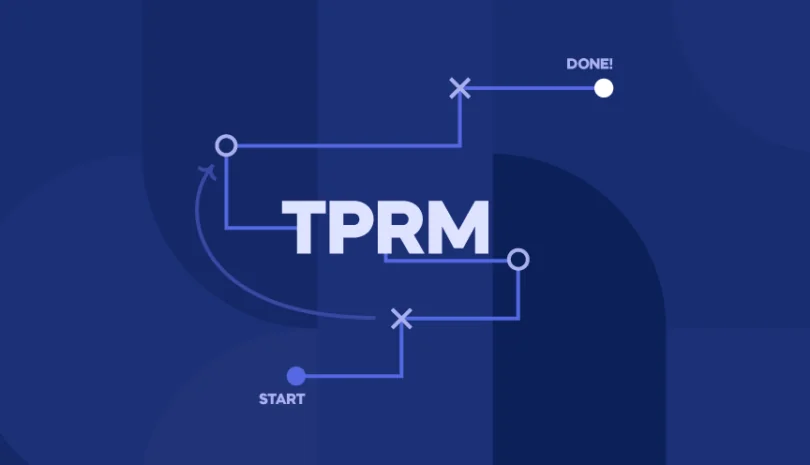Effective cybersecurity is no longer a matter of setting static defenses and blocking known threats. Security teams today are fighting a sophisticated enemy on a battlefield that’s constantly shifting. Their challenge is to build a cybersecurity strategy that is flexible enough to stay one step ahead of malicious actors.
This growing complexity has shifted the spotlight away from isolated protections and siloed security tools and towards the multi-faceted concept of cybersecurity resilience. This is a holistic approach that moves beyond preventing attacks to proactively reducing their impact, ensuring minimal disruption and swift recovery.
What makes this more challenging is that security teams are operating within a complicated network of moving parts. Third parties play an increasingly important role in any digital supply chain, with organizations relying on vendors, contractors, and other players for vital services and/or products that keep them operational. These third parties introduce added vulnerabilities which can become conduits for cyber attacks.
As a result, third-party risk management (TPRM) is a crucial element in any cyber resilience strategy. Organizations need to identify, understand, and monitor all the partners in their supply chain for potential cracks in their wall of resilience.
In this article, we’ll discuss what’s needed for cybersecurity resilience, explore the role of TPRM in ensuring resilient systems, and share best practices for creating an adaptive and responsive third-party risk strategy.
What is Cybersecurity Resilience?
It’s important to know what lies behind the buzzword of cybersecurity resilience. Resilience refers to your ability to anticipate, withstand, and then recover from any kind of challenge. In the context of cybersecurity, this includes overt cyberattacks, data breaches, third-party compromise, disrupted services from third-party providers, and more.
A resilient cybersecurity strategy is one that enables your organization to remain operational and efficient even during and immediately after a cyber incident. It includes preventive and defensive measures, along with backup systems and policies that can continue delivering critical services while an incident is still underway.
There’s arguably nothing new about bringing resilience into cybersecurity, but it’s never been more necessary. Cyber threats are constantly evolving in sophistication and complexity, and becoming more numerous all the time. Attackers are always working to develop new tactics, techniques, and procedures (TTPs) that overcome both traditional security measures and your newer protections.
This makes static defenses redundant, and forces security teams to adopt a responsive attitude that can quickly adapt to emerging threats, address new vulnerabilities, and recover from security incidents. Keeping resilience front of mind in cybersecurity helps ensure that you can deliver vital operations and services without disruption.
Core Elements of an Adaptive Security Strategy
Having established just how much your organization needs an adaptive security strategy, let’s explore what is involved in developing one. A resilient cybersecurity strategy enables security teams to detect the earliest signs of an impending cyberattack, take action efficiently, and ensure that critical business systems remain operational throughout.
This should include:
- Continuous, real-time threat monitoring and response
- Effective risk management that directs resources where they are most needed
- Strong communication with third parties to ensure everyone is aware of emerging threats
Continuous Threat Monitoring and Response
The essence of a resilient cybersecurity posture is the ability to stay one step ahead of emerging threats. Of course, that’s only possible if you’re aware of those threats. Continuous, real-time surveillance and threat intelligence across all your systems is the only way for your team to quickly detect threats and vulnerabilities that need to be addressed.
Together with this, you need fast incident response procedures that are tested regularly. It’s crucial to be able to deal swiftly with threats, ideally with immediate mitigation actions as soon as a threat is identified.
Risk-based Approach to Third-Party Management
Once you’ve got the insights and alerts you need, the next step is to handle them as efficiently as possible. Resilient systems direct their resources to the most immediate and serious threats because these pose the greatest danger of disrupting business operations and/or causing data breaches.
But to identify the most serious threats, you need a powerful third-party risk management system. This allows you to categorize third-party risks according to their immediacy and the criticality of the systems involved so that you know how to prioritize your efforts.
Collaboration Between Internal Teams and Third Party Vendors
Finally, high levels of continuous monitoring and risk-based threat management need to be rolled out across your organization to your entire supply chain. Otherwise your employees could unwittingly create a security incident, or your third parties might unwittingly allow malicious actors access to your systems.
This requires smooth and honest communication between your security teams, all your internal teams, and your external partners, vendors, and suppliers. You need to be sure that everyone in your greater ecosystem is on the same page when it comes to risk and threat management.
The Role of Third-Party Risk in Cybersecurity Resilience
As digital systems and solutions become vital for operational efficiency and business innovation, third parties are increasingly dependent on services delivered by a network of digital providers. While this brings many benefits, it also opens up new risks and vulnerabilities.
Third parties often have access to your sensitive data and critical business systems. Every third-party relationship expands your attack surface, offering more potential entry points for malicious actors.
Additionally, many third-party digital services are crucial for ongoing business operations. If just one of your many third parties is temporarily inoperative, your business could grind to a halt. For example, dozens of credit unions had to suspend operations for several days after their cloud services provider was hit by a ransomware attack. In another incident, Toyota had to pause production at 14 of its car manufacturing plants following a third-party breach.
TPRM is the best way to ensure that you’re aware of third-party vulnerabilities and alerted to changes in their risk posture, which makes it a must-have for cybersecurity resilience. The stringent due diligence and continuous monitoring keeps you informed about possible risks, so that you can take actions to close up vulnerabilities and mitigate potential threats.
The Importance of Third-Party Risk Management
There are a number of specific ways that third-party risk management helps improve your cybersecurity resilience and protect your organization from data breaches and operational disruption. These include:
- Comprehensive assessment for vendor cybersecurity policies that alert you to hidden risks
- Regular audits for third-party systems that keep you aware of changing vulnerabilities and risk posture
- Regulatory frameworks and standards that obligate your third parties to maintain high levels of cybersecurity
Evaluating Vendor Cybersecurity Practices
Every effective TPRM program includes robust vendor cybersecurity requirements. These lay out obligations for third parties and assess the extent to which they meet those requirements. They include specific policies for data protection, access controls, and compliance with relevant regulations, as well as clear procedures for incident response.
With strong TPRM, you’ll have greater confidence that your third parties can withstand cyberattacks and know how to recognize and deal with threats like phishing, ransomware, or social engineering. It also empowers you to insist that third parties meet particular standards to improve resilience for your entire supply chain.
Conducting Regular Audits and Updating Risk Profiles
Effective third-party risk management includes regular audits and cybersecurity reviews. These help detect new vulnerabilities within your third-parties’ systems and policies, identify weaknesses that could permit entry to serious threats, and keep third-party risk profiles up to date.
Frequent audits and reviews ensure that you’re familiar with the evolving risk landscape. This way, you can adjust third-party relationships and make informed decisions about access controls, so that your own systems are able to continue no matter what happens to the rest of your supply chain.
Maintaining Regulatory Compliance
When you have a robust third-party risk management strategy, you’ll verify compliance with various regulations such as GDPR, HIPAA, and DORA. These frameworks and standards ensure that your third parties meet specific requirements regarding access controls, data privacy, encryption, software updates, and more.
Ensuring regulatory compliance for your third parties has the added benefit of increasing your cybersecurity resilience. When your third parties are compliant, it means that they are less likely to have unknown vulnerabilities and serious weaknesses that open up risks of infiltrations and breaches.
Leveraging Technology for Adaptive Third-Party Risk Management
Given that the third-party risk landscape is so complex, with multiple layers of contractors and sub-contractors, you need advanced technology to manage risks and enhance cybersecurity resilience. Artificial intelligence (AI) and machine learning (ML) play a pivotal role.
By analyzing vast amounts of data to identify patterns and anomalies that may indicate potential threats, AI and ML support predictive security. This means taking proactive measures to mitigate vulnerabilities before they become serious.
AI-powered tools also enable real-time risk scoring, based on a set of factors such as compliance status, historical performance, and emerging threat intelligence. Together with this comes adaptive monitoring, which uses risk score data to dynamically adjust security measures and responses to current threat levels. This dynamic approach helps maintain the integrity and resilience of the entire network, safeguarding against potential breaches originating from third-party connections.
Third-party risk management technologies are most effective when you integrate them into your broader cybersecurity framework. This way you can use them to automatically collect and analyze third-party data, build a comprehensive view of security posture across the entire supply chain, and ensure better coordination for risk management between teams.
Developing a Dynamic Response Plan
Once you understand the need for cybersecurity resilience, you’ll want to put the theory into action by creating a dynamic response plan that keeps third parties in mind. It needs to cover several areas, including incident response, contingency planning, and cyber insurance.
Every good security team has incident response plans, but they don’t always consider third-party breaches. It’s important to develop specific protocols for breaches that originate from third-party vendors and nurture smooth communication so that third parties will quickly relay information and coordinate response efforts. Regular drills should include third-party teams so that you’re all prepared for any eventuality.
In a similar vein, contingency plans should go beyond immediate business systems to cover vendor downtime or compromise. You want backup plans and redundancies for all your critical third-party services so that a failure in your supply chain won’t disrupt operations. This could include identifying alternative vendors, and/or creating internal processes to temporarily replace compromised services.
Your cyber insurance and legal considerations should also be tailored towards third-party issues. Ensure that cyber insurance policies cover losses from third-party breaches, and pay attention to limits and exclusions relating to third-party risks. Vendor contracts should clearly define security expectations, breach notification requirements, and liability, so the consequences of third-party incidents are known to everyone.
Best Practices for Building an Adaptive Third-Party Risk Strategy
You also need a flexible third-party risk management strategy alongside your dynamic response plan. Best practices begin with setting clear security standards for all vendors, covering data protection, access controls, encryption, and incident reporting. These standards should be written into your contracts, with consequences for non-compliance. Assess every vendor against your standards before you work with them; carry out regular audits to check that they remain compliant; and review and update standards according to changing threat intelligence.
It’s also a good idea to offer your vendors the same ongoing training and cybersecurity awareness programs that you run for your employees. When your third parties are on the same page about the latest threats, vulnerabilities, and best practices, you’ll foster a culture of vigilance throughout your supply chain.
An effective, responsive third-party risk strategy only works when you collaborate with vendors and share resilience goals. This should include setting up communication channels, demonstrating transparency in sharing threat intelligence, working together on incident response plans, and running regular joint exercises and simulations to test preparedness. When you turn vendors into partners for resilience, you’ll build a unified front against cyber threats.
Cybersecurity Resilience for Third-Party Risk Management
Approaching cybersecurity with resilience in mind is the best way to protect your organization from threats and maintain business continuity. At the heart of resilience lies an adaptable third-party risk management strategy that ensures you’re aware of emerging threats and vulnerabilities within your supply chain, can rely on your vendors to share your resilience goals, and are able to respond to incidents quickly and efficiently.
In the midst of evolving threats and risks, there are a number of steps you can take to strengthen your security posture. These include:
- Enforcing strict access controls and security updates;
- Continuously monitoring network traffic and third-party activities;
- Running frequent security audits and regular incident and recovery drills;
- Carrying out ongoing cybersecurity training for employees and third parties;
- Sharing threat intelligence with your supply chain and industry peers;
- Implementing advanced threat detection, response, and monitoring tools.
Panorays’ third-party risk management solution offers a number of capabilities to help you carry out these steps. The platform carries out detailed supply chain mapping, ensuring that you’re aware not just of third parties, but also of fourth and Nth parties.
Automated questionnaires make it easier to incorporate cybersecurity resilience assessments into your existing due diligence processes, and the AI-powered data collection and analysis engine carries out continuous monitoring and dynamic risk scoring. These enable you to constantly adjust your security policies and procedures to reflect changes to your risk landscape and emerging threats.
Ready to build your cybersecurity resilience? Contact Panorays to learn more.
Cybersecurity Resilience FAQs
-
In cybersecurity, resilience means your organization’s ability to withstand, recover from, and adapt to cyber-attacks and disruptions. It indicates the capability to weather inevitable cyber incidents without losing business continuity or suffering serious data breaches, and to quickly return to normal operations.
-
Cybersecurity focuses on preventing attacks and protecting systems from threats. In contrast, cyber resilience includes the ability to continue operating and quickly recover after a breach or an incident occurs. Resilience means considering proactive measures, response planning, and recovery strategies that can ensure continuity despite cyber incidents.



